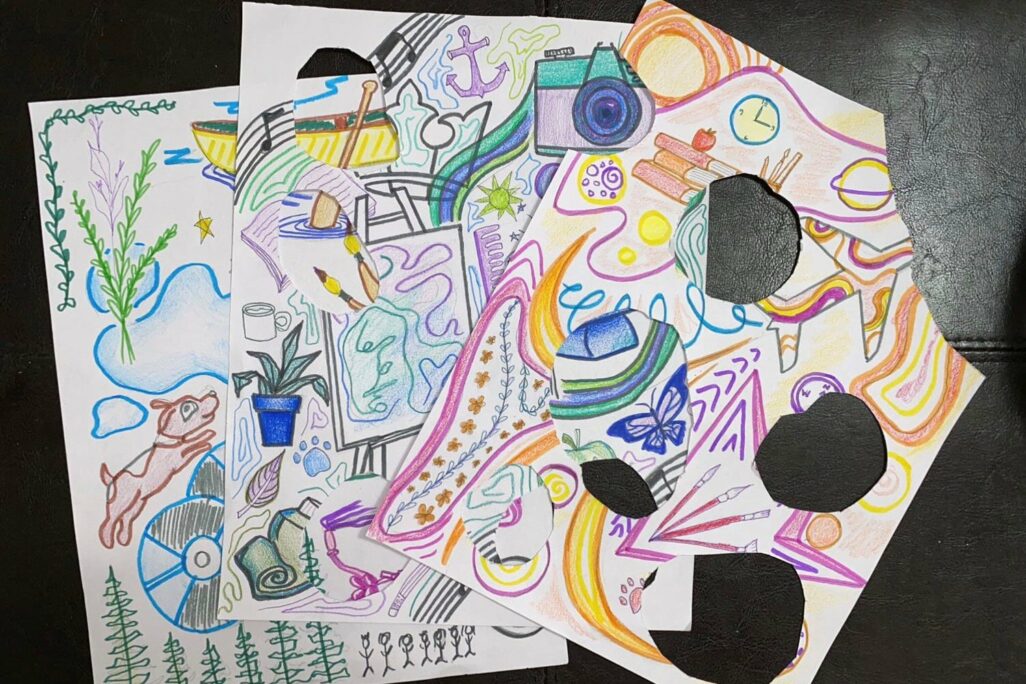About
In this Sunday activity, we will tell stories of our past, present, and future by creating visual look-books. We will make three separate drawings of our past, present, and future, combined to tell our own personal stories.
Things to Think About
- What does it feel like to consider the future?
- How does our past act as a foundation for our present and future?
- What is important to you now that you want to hold on to?
- What do you want to change?
- What are some ways that you can get involved in your community to contribute to the future you want to see?
About the artwork
Youth can be a symbol of exciting possibilities and potential change in our world. Young people have the responsibility of facing current challenges in our world and carving a new path for future generations.
Ukrainian filmmaker duo, Roman Khimei and Yarema Malashchuk have made four video works exploring the complexity of the youth of the world. The films were created between the years of 2017-2021. The films take the audience on a journey, navigating past and historical traumas in search of a future. These four video works toggle between past and future perspectives by following the stories of Ukrainian Youth groups, as they journey through historically rich modern day Ukraine. The video works make many references to the past and the traces it leaves behind, while also communicating both hopes and anxieties for the future. Youth of the World runs for forty minutes in total and showcases Ukraine’s unique but relatable youth culture.
About the Artists
Yarema Malashchuk and Roman Khimei work in Kyiv, Ukraine. Their cinematography artwork explores the crowd as the character. Their videos highlight the deep history and culture of Ukraine to communicate their message. Their art medium is a bridge between visual art and cinema. Both Yarema and Roman graduated from the Institute of Screen Arts in Kyiv, Ukraine as cinematographers. Yarema and Roman have been collaborating since 2013. They have won the main award of the PinchukArtCentre Prize in 2020, the VISIO Young Talent Acquisition Prize in 2021, and the Grand Prix at the Young Ukrainian Artists Award, MUHi, in 2019. Yarema and Roman are both members of the Prykarpattian Theater art collective. This collective recently created the project Theater of Hopes and Expectations between Düsseldorf, Germany and Sloboda-Kukharska, Ukraine.
Studio Activity
In this Sunday activity, we will tell the stories of our past, present, and future by creating visual look-books. We will create three separate drawings of our past, present, and future, laid on top of each other with cut outs acting as ‘windows’ through our journey through life. We invite families to share these look-books with others and describe the story they’ve told through their visual imagery.
Supplies:
- Three sheets of white drawing paper
- Pencils, erasers, sharpeners
- Pencil crayons, markers, oil pastels
- Scissors
- Optional: watercolour paint and paint brushes
Instructions:
Step 1: Think
Think of your unique past and present. Make a list of things that help tell the story of who you are today. Consider things you can pay homage to, or reference with deep respect. The list can include things such as:
- Important people in your life that have influenced you,
- Friends who you have laughed with,
- Family who has supported you,
- Pets that teach you responsibility,
- Hobbies that you enjoy,
- Cultural traditions you have been raised by,
- The small things that make you, you.
Then, think of what future you would like to live in. Make a list of things you hope to achieve in your life.
- What do you do?
- Who are the people who surround you?
- What does your living environment look like?
- What are your family values and traditions?
- Consider the changes you want to see in the way the world is run.
Step 2: Draw
Using the three sheets of paper, draw your past, present and future.
- You can choose to draw these figuratively (meaning to draw objects how they look in real life) or abstractly (meaning to draw a unique visual representation of what the objects means to you).
- Use specific colours to help tell your story. For example, you could use blues and greys to symbolize your past, and bright bold colours to symbolize a bright future.
- Also, consider making your future drawing more abstract. Is it possible to draw the future? Can you predict where you will be 20 years from now?
Step 3: Cut Outs
Using scissors, cut out holes and shapes on only your present and future drawings. These holes do not all need to line up with each other, they will act as windows to the drawing beneath. The holes can vary in both size and shape. Consider what parts of your drawing you want to keep, and what parts will be cut out.
Step 4: Assemble
Lay your drawings one on top of each other with the past drawing on the bottom, present drawing in the middle, and future drawing on top. Move the papers around to peek through the ‘windows’ or holes you have cut out, to try and see into the past. Think about how some things from your past and present can still be seen, and what has disappeared. Reflect on how this applies to your own life, as a young person.

